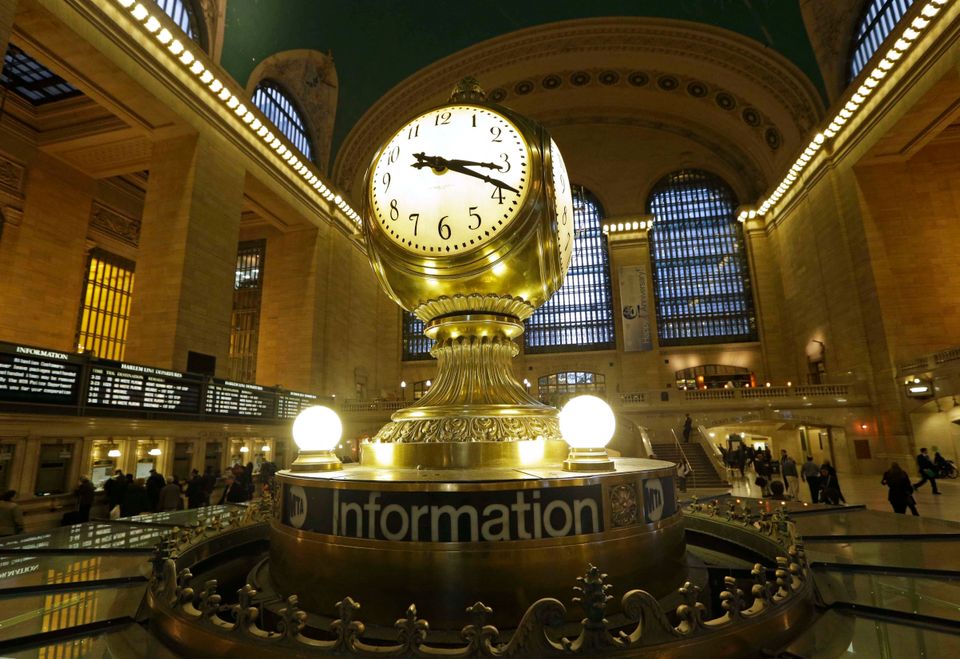
Grand Central celebrates its 100th birthday Friday. We talked to Sam Roberts, author of the new book "Grand Central: How a Train Station Transformed America," about why the city landmark looms so large in in the country's culture and history.
Roberts, who is also the Urban Affairs Correspondent for The New York Times, chronicles Grand Central's development and reflects on his own memories of visiting the iconic station.
HP: Describe your first memory of Grand Central and how did it affect your view of the city as a whole? Has that feeling changed or remained the same over the years?
SR: I was a kid from Brooklyn and my father took me to Grand Central to visit. I remember staring longingly at a gleaming New York Central locomotive. The engineer leaned out of his cab and said, “Hey, you want to drive this thing?” He put me on his knee and placed my hand on the throttle. We probably drove a few feet, but to me it seemed like a mile. New York, epitomized by Grand Central, became the city of endless possibilities. It still is.
HP: How did Cornelius Vanderbilt's original blueprint for Grand Central change over time?
SR: We tend to take Grand Central for granted, but I learned so much in researching this book. When the original station opened, The Times carped that it was neither Grand nor Central – too far uptown. But Grand Central eventually brought midtown to its doorstep and shifted the city’s center of gravity. Today’s Grand Central is the result of a shotgun marriage between two architectural firms: Reed & Stem (they sound like landscape architects) and Warren & Wetmore. Stem was the brother-in-law of the railroad’s chief engineer. But Warren was a cousin of the Vanderbilts. The resulting partnership proved greater than the sum of its parts. Ambitious blueprints for a “Terminal City” were only partially realized. Mercifully, plans for the world’s tallest building atop the terminal were abandoned, although by building the structural supports for the tower, the architects unwittingly set the stage for the fight decades later in which the Supreme Court, for the first time, upheld a locality’s legal right to preserve a privately-owned historic landmark.
HP: How does Grand Central play into today's culture? What is your favorite appearance in a film, book, or television show in which Grand Central makes an appearance?
SR: After we agreed on the subtitle to “Grand Central,” “How a Train Station Transformed America,” I wondered whether I’d be able to live up to it. I was stunned by how much Grand Central has threaded itself into the culture. Standard Time began there (the man who conceived it was, unfortunately, later run over by a train). The civil rights movement was nurtured at Grand Central, through A. Philip Randolph and the Brotherhood of Sleeping Car Porters. Go anywhere in the world and say, “This place is like Grand Central Station” and everyone will know you mean frenzy, bustle and controlled chaos. From the old radio program “Grand Central Station” (Joan Didion’s introduction to mythical Manhattan) to “Mad Men,” Grand Central has become a global cultural icon. Think “The Fisher King,” “Midnight Run” and “Madagascar,” countless books (James Patterson’s “Kill Me If You Can” to Mark Helprin’s “Winter’s Tale”), to name just a few. My favorites: “North by Northwest,” when Cary Grand calls home from a Grand Central phone booth before embarking on the 20th Century Limited, “The House on Carroll Street” and “Superman,” in which Gene Hackman’s Lex Luthor manages his evil empire from the bowels of Grand Central and boasts of his Park Avenue address. To which his floozy secretary replies: “Park Avenue address? Two hundred feet below?”
[INTERVIEW CONTINUES BELOW
]
In this Jan. 30, 1975, file photo, Jacqueline Kennedy Onassis, center left, and Bess Myerson, center right, walk with architect Philip Johnson, left, and Rep. Ed Koch, right, as they leave New York's Grand Central after holding a news conference for the "Committee to Save Grand Central Station." Koch, the combative politician who rescued the city from near-financial ruin during three City Hall terms, has died at age 88. Spokesman George Arzt says Koch died Friday morning Feb. 1, 2013 of congestive heart failure. Photo: AP
HP: You talk about station's role in expanding New York City and other city suburbs around the nation. You even make the argument that Grand Central helped changed the composition of the American family. How so?
SR: Ask any banished suburban housewife, harried commuter or teenagers exiled to a metropolitan area’s leafy out-of-town precincts whether Grand Central shaped the American family? Gail Sheehy’s searing caricature of the commuter still resonates – especially her “Belles of the Bar Car,” although women now make up a much bigger share of regular riders. And, don’t forget the legendary silver vase found on a train seat. It wins the prize for weirdest misplaced item, hands down. It turned out to be left deliberately by a widow whose husband claimed a few too many times that he came home late because he had been stuck on a train. The vase contained his ashes, and his wife figured leaving them on a train indefinitely was just retribution.
HP: How did Grand Central impact the idea of a "work commute?"
SR: Commutation – not of a prison sentence but of a regular rider’s fare – was born at Grand Central when a perceptive railroad superintendent remembered only as M. Sloat noticed a new class of customer: the repeat passenger, whose to-and-fro trips to work and home represented a potential marketing bonanza. The result: a blossoming of bedroom communities near railroad stations in Westchester and Connecticut.
HP: Upon its construction, what types of structural innovations did the station create?
SR: Electrification of the railroad – following a fatal crash caused by smoke that obscured the engineer’s view – produced a number of other benefits. The railroad could build a bi-level terminal – making it the largest, by number of tracks and platforms, in the world. And the train yards north of Grand Central could be decked over – creating billions of dollars in valuable real estate from the air rights that were first monetized to this degree. Ramps (later adopted by airports) lightened the load for luggage-toting travelers. Viaducts sped motorists around the terminal, which would otherwise have obstructed Park Avenue traffic.
HP: Where is your favorite place to people watch? How often do you find yourself in Grand Central?
SR: I get there as often as I can – at least once a week, and usually as a subway rider. My favorite spot is to stand on any of the terminal’s balconies to watch the urban ballet on the Main Concourse (so well choreographed that hundreds of thousands of extra never seem to bump into each other) and the silhouettes of passersby on the glass catwalks.
HP: In terms of New York City landmarks, how important does Grand Central represent this city, its history?
SR: Penn Station did not die in vain. Grand Central is, as Paul Goldberger wrote, the poster building for landmarking. Among the many fascinating insights I gleaned from researching the book was that New York City officials were afraid to appeal the court decision voiding landmark status for the terminal – they feared they would be held liable for damages by the bankrupt Penn Central railroad, which wanted to build a tower atop the terminal. Thanks to good lawyers and Jacqueline Onassis’s advocacy, the appeal was successful, Grand Central was saved, and the precedent spared thousands of other historically and architecturally vital places all over America.
HP: The Oyster Bar, the Apple store, etc. How did Grand Central become the commercial hub that it is?
SR: They Oyster Bar was actually the terminal’s original tenant in 1913 and since then, especially since the terminal was meticulously renovated, commercial opportunities which generate revenue for the publicly-owned railroad have proliferated. (The Apple store, the nation’s largest, blends so well into the décor that the most asked question at the famous information booth – after where are the restrooms – is how to find it.) Terminal conjures up endings, but Grand Central is a place of new beginnings – not the least of which is its own. Metro-North and its parent Metropolitan Transportation Authority transformed a neglected remnant of the Gilded Age into a vital destination – for sightseers, diners, shoppers, and, yes, for commuters. It is a democratic place, attracting people from the subways and the suburbs. And, to think that so majestic a building, born of private enterprise as a gift to the city, was revived by the enlightened self-interest of government investment.
For more from Roberts, be sure to check out "Grand Central: How a Train Station Transformed America."
